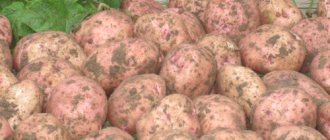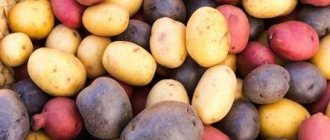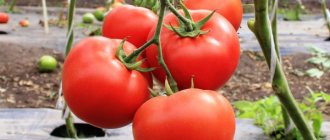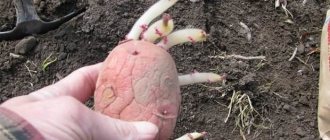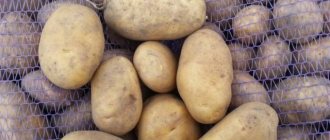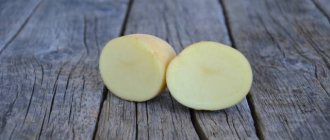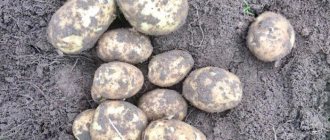Description and characteristics
| Growing season | 75 days before ripening, technical ripeness phase in 105-115 days |
| Aboveground part | The stems are tall, the bush is vigorous, straight or semi-spreading. The leaves are large, slightly wavy. Corollas medium or large, white |
| Tubers | Oval, oblong; eyes small/medium recessed |
| Peel | Smooth/slightly rough, thin, yellow |
| Pulp | Light yellow, with a dense structure |
| Starch content | 12,2-16,4% |
| Dry matter content | 20,7-21,3% |
| Weight | 100-150 g |
| Product output | 89-95% |
| Quantity in slot | 6-9 pieces |
| Productivity | 290-460 c/ha, maximum – 583 c/ha |
| Rest period during storage | 97% |
| Features of the growing season | Drought resistance, adaptation of the variety to different types of soil |
| Disease resistance | Immunity to potato cancer and wrinkled mosaic, golden nematode infection. The variety is moderately susceptible to leafroll virus, band mosaic and late blight. |
The mid-early table variety Labadia has a good taste and, after cooking, retains a pleasant creamy-yellow hue. Labadia is used for baking, frying, French fries, chips, since according to the European classification of table varieties it belongs to group “B” - slightly mealy, universal. When cooked in water, the potatoes will soften a little.
Attention! Labadia table potatoes need sufficient fertilizer for a rich harvest. At the same time, the proportion of nitrogen preparations for vigorous plants is reduced.
History of the origin of the Labadia variety
Labadia is a potato variety of Dutch selection, bred in the Netherlands by specialists. It was included in the State Register of the Russian Federation in 2010 and since then has been actively cultivated in various regions of the country, although it is recommended for cultivation in the Central, Volga, North Caucasus and Southern regions of Russia.
Did you know? Green potato tubers contain the toxic substance solanine, which in large quantities can cause serious poisoning. True, to be poisoned by such potatoes, you will have to eat at least a kilogram of raw tubers or several pieces of berries, which is unlikely to occur to anyone.
Labadia potatoes are highly resistant to prolonged drought and do not place high demands on the composition of the soil in which they are grown. In warm climatic zones, when tubers are pre-treated with biostimulants for growth, it is possible to harvest not one, but two harvests of tuber crops per season.
Advantages and disadvantages
| Advantages | Flaws |
| Excellent commercial properties: large, one-dimensional tubers, light, slightly rough skin texture; keeping quality and transportability | Tubers planted without light sprouts germinate slowly. Mandatory germination period |
| Pleasant taste | Do not plant early in cold soil |
| High stable yield | Prone to external mechanical damage, but the dense structure remains without flaws |
| Tolerates drought. Adapts to different soils | |
| The variety is resistant to dangerous potato diseases |
Landing
Growing Labadia potatoes will bring a stable harvest from all types of soil. In terms of acidity, soil with a pH reaction of 5.1-6.0 is better suited. Without a laboratory, you can approximately determine the acidity of a potato site. If there are daisies, clover, dandelions, wheatgrass, coltsfoot, potatoes will also bear fruit well. In autumn, the soil is enriched with manure, bird droppings or superphosphate, potassium mixtures, and ammonium sulfate.
In the southern regions, the Labadia variety can be grown 2 times per season if the correct agricultural practices are followed.
- Germination in light takes 20-30 days. Without sprouts, the seed takes a long time to awaken.
- Before planting, it is advisable to treat potatoes with growth stimulants.
- Labadia potatoes are placed according to a 70 x 35 cm pattern.
- They are planted in soil that has warmed up to +8°C to a planting depth of 8-10 cm. If the recommendations are followed, the shoots will be uniform and friendly.
Growing technology
A great variety of methods and technologies for growing potatoes have been invented - both in bags and in boxes. In general, who is good at what. We will consider only two polar opposite technologies:
- The classic option is growing in open ground.
- An eco-friendly option for the lazy - under the straw on the grass.
In the open ground
Potato planting material has been prepared since the last season, from the moment of harvesting the previous harvest. Before storing the potato crop, it is necessary to select the healthiest, beautiful and even tubers for planting next year. It is not necessary to take very large tubers, but even very small ones will not yield such a great harvest.
Potatoes selected for planting must be stored separately from the main potatoes to prevent the possibility of infection with fungal diseases. The container must be ventilated, but if stored in a dry cellar, the pile storage method is also suitable.
In spring, potatoes are taken out of a cold basement or cellar a week or two before planting and transferred to a warmer place for germination.
Important! It is not necessary to sprout potatoes; you can also plant unsprouted tubers. But sprouted potatoes sprout much earlier
Potato sprouts should be from 10 mm to 50 mm. Too long - 150 mm will simply break off when deepened.
As you probably know, if potatoes are planted from year to year, choosing planting material from the previous year's harvest, over time the potato variety degenerates and the tubers become small. Experts recommend using seed potatoes as part of the planting material to update the variety, which in themselves are not cheap.
But there is another way to update the variety: cut the sprouted tubers into several parts and plant them separately. We will talk about this method.
You can plant potatoes in the ground when the ground warms up to at least +8 - +10 °C. If in your region there are serious spring floods with flooding of the beds, then you will have to wait them out, since potatoes planted in too wet soil will either rot or will certainly produce a sick crop.
This root vegetable loves slightly acidic soil; it grows best on sandy loam and sand, black soil, although a good harvest can be grown on clay or peaty soil.
Before planting, the bed must be loosened to a depth of 20 - 25 cm, removing harmful weeds - wheatgrass, for example. The following is the technology:
We dig a hole with a bayonet shovel 12 - 18 cm deep. We throw a handful of rotted manure to the bottom, kneading it thoroughly and crushing it in our hands.
We take a potato tuber and look at the location of the sprouts. It’s good if there is at least one strong sprout on both sides of the tuber, preferably two. Carefully cut with a sharp knife so that you get two parts of the tuber, each with a sprout or two.
We burn the cut of the tuber with wood ash. To do this, we lower it into a container with ash and carefully, but carefully, scroll there so that there is no empty space left, not covered with ash.
We lower the tuber into the hole so that the sprouts look up.
Sprinkle with soil.
As you can see, there is no special wisdom in planting potatoes. The most interesting thing will begin with the emergence of seedlings.
Growing potatoes under straw
This method of growing is not universally popular among ordinary gardeners, only among those who like to try something new. But adherents of organic farming use this technique to get rid of wheatgrass in virgin lands.
So, to grow potatoes under straw on grass, you need a plot of undeveloped virgin land. Tubers of planting material are laid out on the site in a square-cluster manner. From above, all this is covered with straw in a layer of at least 30 cm. Wooden stakes or other material are placed on the straw so that it does not fly apart.
That's all. During the growing season, this bed is only watered occasionally. Neither hilling, nor loosening, nor weeding, nor even treatment against the Colorado potato beetle is carried out.
Important! The only problem that may arise when growing potatoes this way is mice. But it can be easily solved by having a cat
By the way, many mice did not even breed in straw. As a control measure, elderberry and wormwood branches can be laid out on the straw.
The harvest is harvested in due time. To do this, carefully remove the straw with a pitchfork. There will be potato “pods” under it.
All weeds should be completely rotted under a layer of straw. So next year it will no longer be virgin land, but a clean, fertile bed on which you can grow anything you want.
Care
Despite all the unpretentiousness of the Labadia variety, it needs to be carefully looked after.
- The area with potatoes is regularly loosened, providing the root system with sufficient air access, and weeds are removed;
- When it rains, water only before the flowering phase, then the crop especially needs moisture;
- In dry season conditions, watering is important when the stems reach a height of 6 cm, then before and after flowering;
- Up to 50 liters of water are used per square meter to moisten the layer of soil where the tubers develop.
Hilling and feeding
Vigorous Labadia potato bushes are hilled high so that the large tubers that are forming do not turn green in the sun. The first hilling is carried out when the stems are 12-15 cm high. The next one is done after 2-3 weeks. Hill up for the last time before flowering.
The Labadia potato variety needs to be fed even on fertile soil.
- They begin to fertilize potatoes when the plants reach a height of 15 cm: 5 g of urea are dissolved in 10 liters of water and 0.5 liters are poured under the bush.
- Infuse manure or chicken droppings: 500 g per 10 liters of water. Then the infusion is diluted 1:10 and watered between the rows.
- Before flowering, dissolve 200 g of wood ash or 20 g of potassium sulfate in 10 liters of water. Water 0.5 liters under each bush.
- During flowering, to activate the formation of tubers of the Labadia variety, potatoes are fed with a solution of 20 g of superphosphate in 10 liters of water. You can also add a solution of mullein or bird droppings. Consumption – 0.5 l at the root.
Warning! Potatoes are fertilized after abundant watering.
Reviews
Ivan Andreevich, Voronezh, 45 years old.
We grow Scarb and Queen Anne (we especially love the second one). But that year we decided to try Labadia. What can we say, the variety is good. The tubers are large, smooth, tasty. Only 5 kg were planted. The care is minimal, since the city ones themselves planted them in the country. Of course, it doesn’t compare to Anna’s in terms of taste (for our family personally), but it also deserves respect.
Elena Yurievna, Kyiv, 54 years old.
We grow 5 varieties, including Labadia. On average, one hole produces 6-7 large tubers. The taste is average, the appearance is wonderful.
Dmitry Alexandrovich, Rostov, 51 years old.
We constantly grow this variety. The taste is good, the yield is high. During the entire cultivation period, which is about 6 years, I never got sick with anything.
Diseases and pests
| Diseases/pests | Signs | Treatment |
| Late blight | Dark spots form on the stems and leaves, later a gray coating. In rainy weather and temperatures below +15°C, the fungus spreads throughout the entire area in 10 days | Labadia potatoes are treated prophylactically with fungicides Baktofit, Arcerid, Quadris and others. Healthy tubers are selected for planting |
| Scab | Only tubers are affected. Brown or black cracks with rough edges form on the peel. The fungus develops at high temperatures. Starchiness is significantly reduced | The fungus persists in the soil for more than 3 years. Planting potatoes are treated with Fito Plus. They also spray potato bushes during the growing season. |
| Brown bacterial rot of potatoes | When the plant blooms, the tops begin to fade, the leaves turn yellow, and the veins at the bottom of the stem are affected by rot. Tubers rot during storage | Potatoes cannot be planted on the affected area for 5 years. Planting tubers are heated for germination, and then sorted, removing the affected ones. Spray with Baktofit before planting and twice before flowering |
| Potato moth | Butterflies, similar to clothes moths, flutter over the bushes if you move them. The plant and tubers suffer from small larvae - 1-1.3 cm. With a large infestation, the moth may have time to lay eggs in the tubers that are closer to the surface | Insecticides. High hilling is carried out, which is required according to the technology for the Labadiya variety. |
